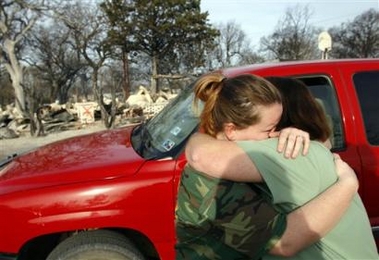|
Wildfires char homes in US Oklahoma, Texas
(AP)
Updated: 2005-12-29 16:03
By the time the smoke cleared Wednesday, more than 100 homes across
wildfire-stricken Texas and Oklahoma, the United States, lay in ruins and
at least five people were dead, including two elderly women trapped in their
homes by the flames.
The hardest-hit community during Tuesday's blazes was Cross Plains, a West
Texas ranching and oil-and-gas town of 1,000 people some 150 miles from Dallas.
Cross Plains also lost about 50 homes and a church after the flames raced
through grass dried out by the region's worst drought in 50 years.
Two elderly women there were killed after being trapped in their homes, said
Sparky Dean, a spokesman for the Department of Public Safety.
Another woman died in Cooke County, near the Oklahoma line, after she
apparently fell while helping her husband pour water on the grass around their
house, said Mike Murphree, a division chief for the Gainesville Fire Department.
He did not know how she died.
No information was immediately available on the fourth death in Texas. A
fifth person was killed in Yeager, Okla., where fire destroyed eight homes.

Kristin Hunter, left, hugs her mother, Terri
Hunter, after learning that a neighbor is unaccounted for following a
grass fire that swept through the small town of Cross Plains, Texas,
Wednesday, Dec. 28, 2005.[AP] | "We had a tornado here years ago and we thought that was devastating. This
lasted for hours and hours," said Patricia Cook, a special education aide whose
Cross Plains home was saved by her 18-year-old son, J.D., and a friend. They saw
the flames approaching the house from across a field and ran to save it.
"The fire was literally nipping at their heels," she said. "He just picked up
the hose and started watering things down."
Elsewhere on her block, the front brick wall and part of a side wall were all
that were left standing of the First United Methodist Church. The steeple lay
across the ground. Ten other homes on her street also were reduced to charcoal.
Most of the homes destroyed in Cross Plains were modest, working-class houses
built during the 1930s and '40s. The fire spared a town landmark, the nearly
century-old house �� now a museum �� of Robert E. Howard, author of the "Conan the
Barbarian" books.
All together, the grass fires destroyed more than 100 buildings across Texas,
including 78 homes, the state emergency management agency said. About 50 homes
have been destroyed in Oklahoma, authorities said.
Some residents of Mustang, just west of Oklahoma City, returned to their
homes Wednesday to pick through what remained after wildfires whipped through
the community a day earlier.
Daniel Gonzales, 27, briefly tried to save his parents' home with a garden
hose but ended up just retrieving some family photos, a file cabinet, a painting
and two antique chairs while the house burned.
"The front door was on fire, and I could hear the flames going crazy through
the roof," said Gonzales. "There was smoke everywhere."
On Wednesday, a charred, grinning snowman decoration stood beside a birdbath
filled with black water and splinters of broken wood on the front lawn.
"We were planning on dying here," said Gonzales' stepfather, Pat Hankins, 62,
who lived in the home with his wife for 13 years. "We loved this piece of
property. Whether we'll rebuild, I just don't know."
Wind gusting to 40 mph drove the flames across nearly 20,000 acres in the two
states. At least 73 blazes were reported in Texas over two days, and dozens more
broke out in Oklahoma.
Fires were still smoldering Wednesday in four Texas counties. One new fire
broke out Wednesday in an isolated area of eastern Oklahoma but was quickly
contained.
Severe drought set the stage for the fires, which authorities believe were
started mostly by people shooting off fireworks, tossing cigarettes or burning
trash in spite of bans imposed because of the drought. A fallen power line
apparently started one Oklahoma blaze.
Rainfall this year in the Dallas-Fort Worth area of North Texas, where most
of the fires broke out, is about 16 inches below the average of about 35 inches,
National Weather Service meteorologist Alan Moller said.
"The last time we had something quite this bad, you got to go back to about
1956, when we had 18.55 inches," Moller said.
The weather service's long-term forecasts show the drought intensifying
through early 2006.
Oklahoma has received about 24 inches of rain this year, about 12 inches less
than normal.
|